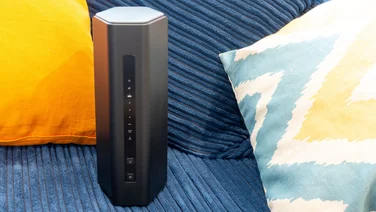To help us provide you with free impartial advice, we may earn a commission if you buy through links on our site. Learn more

- Impressive coverage
- Four Gigabit Ethernet ports on each node
- Works with Alexa
- Can't blacklist clients
- Slow app
Zyxel’s bulging Multy X modules look rather cheap next to the classy discs of BT Whole Home Wi-Fi and friendly cylinders of Google Wifi – and with a sizeable footprint of 236 x 178mm, they take up more shelf space than most rivals, too. But these nodes are large for a reason: each one crams in a dedicated 4×4 antenna array for the backhaul, providing a huge theoretical bandwidth of 1,733Mbits/sec, alongside separate 2×2 arrays for connected clients.
In practical terms, this means the nodes can communicate between themselves faster, and over longer distances, than most other mesh systems. In my own house, I was able to connect the primary node to the modem in the living room, haul the other node all the way to the utility room at the rear of the house, and still – according to the signal meter that’s built into the Multy X smartphone app – enjoy a “perfect” connection between the two.
READ NEXT: The best wireless routers you can buy
That, in turn, translated to some seriously impressive wireless coverage. No matter where I roamed around the house – indeed, even when I strayed out onto the exterior terrace – I enjoyed the kind of blazing speeds that had previously only been attainable when sitting right next to my old router. Even on the slower 2.4GHz band, the connection topped 5MB/sec almost everywhere around the building.

That alone would be enough to earn the Zyxel Multy X a warm recommendation, but there’s other good news, too. I’ve complained elsewhere that two Gigabit Ethernet ports isn’t really enough for a system that intends to replace your router. The Multy X shows how it should done, offering a generous four ports on each node, so you can attach up to seven wired clients without needing to mess around with switches. It’s just a shame that the USB 2 port at the back of each node doesn’t currently do anything – it would be nice to be able to connect an external hard disk, but Zyxel says the connector is “reserved for future usage”, and I suggest you don’t hold your breath.
I was also pleased to note that splitting up the 2.4GHz and 5GHz wireless bands is as easy as flipping a toggle in the Multy X app. By default the 5GHz network is, slightly oddly, distinguished by having “.speed” appended to its SSID, but you can change it. There’s a very simple parental control system too, which lets you configure internet access schedules for single devices or groups.

As a final bonus, the Multy X system works with Alexa, so if you have an Amazon Echo device you can verbally instruct it to disable the guest network, test your internet speed or temporarily suspend internet access. It would have been nice to reboot the router with a voice command, but if your internet is glitching then Alexa probably won’t work anyway.
While the Multy X gets a lot right, it does hit a few bum notes. Yet again, you’re stuck with a custom IP range – 192.168.212.x, if you’re interested – which will be frustrating for anyone who has their IP addresses set up the way they like them. And, as with Google Wifi, while you can inspect your connected clients, you can’t blacklist any that shouldn’t be there. (You can cut off their internet access, but they’ll still be able to talk to other devices on your LAN.)
Be warned too that, while the smartphone app is quite capable, it’s slow: as you tap around its various pages, you’re frequently left staring at a spinning wheel for five seconds or more while the app queries the nodes for whatever information it needs. You can’t even work around the issue by using the web interface, because there isn’t one. Visit the gateway in your web browser and you will be greeted with a terse “not found” error.
A final caveat is that the Multy X doesn’t operate as a true mesh network – it uses a star configuration in which all nodes talk directly to the router. An update is promised in March that will add support for daisy-chained configurations – but if you were thinking of investing in additional units then be warned that, as things stand, they may not extend the system’s range by as much as you would hope.
Zyxel Multy X review: Verdict
For those of us who don’t live in mansions, though, the Zyxel Multy X is a fantastic system. It may not be the most aesthetically beautiful networking kit on the block, but it delivers screamingly fast Wi-Fi over an impressively wide area, for a price that’s extremely reasonable.
![Zyxel Multy X Tri-Band AC3000 Whole Home Wi-Fi Mesh System. Router and Satellite - Pack of 2 [WSQ50]](https://m.media-amazon.com/images/I/31s4JhPDrPL._SL160_.jpg)






